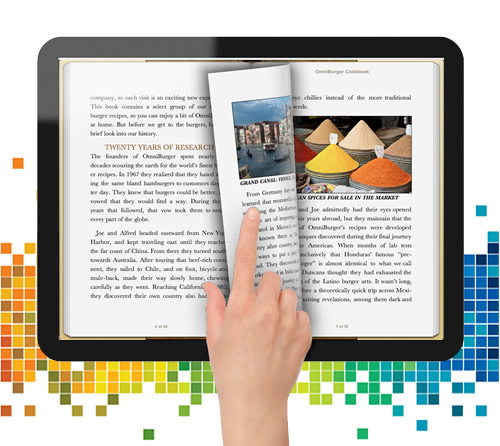A Comprehensive Guide on How Publications Can Go Digital

Table of Contents
- Understanding Digital Publishing
- Digital Media vs Print Media
- Benefits of Digital Publishing
- What is a Digital Publishing Platform?
- Top Digital Publishing Platforms for 2022
- Step-By-Step Strategy for Going Digital
- Key Takeaways
- Conclusion
- FAQs
The world around us is increasingly turning to digital for everything, be it payments, experience, or even access to information. Digital Publishing is thus gaining prominence, and we can even see big publishers now adopting a fully digital strategy.

A key example would be Conde Nast, which ended its print edition of Teen Vogue to being only available digitally. Online publishing or digital publishing is a great way to provide access to your target audience on any device or platform they are using – be it content published in magazines, newspapers, journals, books, or any other.
But is the world of digital publishing relatively new or completely unknown to you? We’ve put together a detailed guide to help you understand what exactly digital publishing is. We also talk about how you can transition your publishing processes online to become an interactive digital publication in 2022.
Understanding Digital Publishing
Digital publishing, also called online publishing or e-publishing, distributes content in any digital medium. This can be on the web or electronic devices and include digital magazines, online newspapers, eBooks, whitepapers, reports, blogs, digital brochures, or any other form of content in a digital space. Users can access this content from multiple devices like computers, laptops, smartphones, e-Reader, tablets, or other devices.
While written content is still the core of digital publishing, other media types are also crucial to digital publications. These include videos, infographics, podcasts, and digital animations, which are often embedded as part of an interactive digital publication.
Digital Media vs. Print Media
Despite the shift to digital publishing today, print media still has its own reasons to sustain. Here’s a quick comparison to help understand the uniqueness and similarities between print and digital publishing.
| Parameters | Print Media | Digital Media |
| Media Types | Newspapers, print magazines, journals, advertorials, etc. | digital magazines, online newspapers, eBooks, whitepapers, reports, blogs, digital brochures, etc. |
| Medium | Always on printed paper | No physical requirement as it is published online |
| Accessibility | Limited to the location that the publication operates in | Anyone with an internet connection and an electronic device can access |
| Flexibility | Limited content due to limitation with paper printing | No limit to content although each piece has a word limit |
| Media | Only printed pictures, often requiring high cost depending on image quality | Interactive pictures, still photographs, and videos can be embedded with copy |
| Ability to update | No option to make changes or updates once printed and distributed | Allows the option to edit, remove or add new content without any limitation |
| Audience type | Mainly elderly or millennials who are more comfortable reading printed materials | Gen-Z and Millennials who are used to consuming content digitally |
Benefits of Digital Publishing
Given the limitations of print media, many content developers, readers, and viewers are moving to adopt digital publishing in one form or the other. For most businesses, relying only on print publishing is no longer an option, especially given the flexibility and ease of use digital publishing offers.
So, here is a look at the immense benefits that digital publishing brings:

Ability to reach a wider audience
Digital publishing enables publishers to reach a wider audience since there is no limitation to distribution. With 4.66+ billion active internet users globally in 2021, anyone can access digital publications conveniently from any location.
Better navigation
In traditional or print media, the reader has to navigate pages and read through headlines or other content pieces to find relevant information. The user can often get lost in print magazines or newspapers, where each page has multiple content pieces. This makes it difficult, especially if the reader wants to locate some stats or information for instant use.
Online or digital publications allow users to search using keywords and find the exact match, helping them find the relevant information or section in seconds.
Visual content offering
With the rise in digital mediums and technology use, the attention span of most users to reading content has been minimized. This has led to increased content consumption in a visually appealing format. According to TechCrunch, visual content creation and consumption have increased 842% since early 2016.
While print offers the ability to use images and beautiful designs, it’s limited in many ways. With digital publishing, audiences can see videos, infographics, GIFs, and even still pictures integrated into the publication. This makes the content more visually appealing and easy to consume.
Interactive advertising
Advertising is one of the major revenue sources for publications, be it print or digital. However, advertisement is static in print media, and advertisers usually have to pay a huge sum to be featured on the first few pages or in key sections.
With digital media, the ad space is dynamic. This means that ads can be showcased to users based on their needs, target audiences, and even include compelling CTA (Call to Action) to ensure interested users can easily view the advertiser’s website or page.
This significantly improves the ad quality and targeting, which is a win-win for both publishers and marketers.
Easy to understand & track key metrics
In print media, it’s often difficult to understand which content is creating a higher buzz or what the audience may like or dislike. This is often due to the audience having the entire material, and there is no way to trace which content or advertisement is getting more engagement.

For digital publications, it is extremely simple to understand page views, the amount of time spent on each content piece or page, and even track navigations. This enables publishers to get detailed analytics and better understand the customer, which is completely missing in a traditional medium.
Increased ROI
Digital publishing can generate additional revenue, as it can reach a wider audience and help expand the publication’s reach. In addition, there is huge cost savings as costs for printing, materials like paper, ink, and other raw materials in the traditional print process are not required.
Thus, publishers can explore omnichannel approaches and expand their horizons to newer opportunities.
Easier post-publishing updates
Often, information gathered during the time of publishing can change or require updates. With print format, updates or edits after publishing is impossible. With digital publishing, minor faults can be edited even post publishing, and one can even take down articles or content that may be irrelevant or contain malicious information.
What is a Digital Publishing Platform
Ready to explore the world of digital publishing? Although publications can often invest in creating their own website or app for sharing content, tons of digital publishing platforms are available that you can explore and begin your online journey a lot faster.
Online publishing platforms are the ideal tools to help you create, edit and even share content digitally. While there is no one way to publish content in the digital space, some of the key digital publishing platforms include:

- WordPress: To build a website and complete blogging platform from scratch.
- Medium: To share blogs and articles.
- Adobe Experience Manager (AEM): To control all your content requirements in one platform, be it email, website, or social media channels.
- Amazon Kindle Direct Publishing: A self-publishing platform for sharing eBooks or publishing the extensive content that helps you earn royalty with each download.
- Digital Magazine Publications: ISUU, Flipsnack, Joomag
Step-By-Step Strategy for Going Digital
To get started on your digital publishing, follow these key steps:
Set goals
To embark on the right path in your digital journey, is it important to know what you are planning to achieve through your online publication? Is it to generate more leads, reach a wider audience, or something else? Focus on knowing exactly why you are creating an online channel, as this will help you port the right materials online.
Know your audience

Next, you need to know who your audience is, as this will help you craft specific content to reach them. We highly recommend creating a target persona based on interactions with existing subscribers or customers, to know some key attributes such as:
- Demographics – age, behavior, or other attributes
- Location
- Interests – and how your content relates to it
- Beliefs – mindset, attitude, or common misconceptions
- Needs – what do they need, and how can your brand help them achieve these goals?
Select the right content publication
Digital publishing includes content in many forms like:
- Digital Magazines
- Online Newsletters
- Digital Catalogues
- Online Brochures
- Blogs
- eBooks
- Whitepaper
- Online Newspapers, or Publishing Platforms
- Interactive Presentations
To make a successful online presence, it is crucial to know which platform to leverage and what type of content you should be creating.
Share your content on multiple platforms
Once you’ve published your content, make sure it is distributed to multiple platforms. Unlike a print medium, digital content can be easily converted into specific emails, social media posts, infographics, and other interactive mediums.
Omni-channel publishing or distribution helps you explore multiple platforms and provide content in various formats, ideal for today’s digital era. Plus, it allows you to increase your brand awareness and reach a wider audience.
Track your metrics
It is important to check how your content is performing on a timely basis. We highly recommend using programs like Google Analytics for your website or other platforms to understand performance depending on your content type. This can help you know which content works best, which is the topic your audience likes, the best time to publish, etc., to help make the right optimizations.
Key Takeaways
- Digital Publishing is gaining prominence. We can even see big publishers now adopting a fully digital strategy.
- It is essentially the distribution of content in any digital medium. Digital content formats include digital magazines, online newspapers, eBooks, whitepapers, reports, blogs, digital brochures, or any other form of content that is in a digital space.
- It enables publishers to reach a wider audience since there is no limitation to distribution.
- It can create more visually-appealing content, which is currently in vogue.
- It has the potential to generate additional revenue, as it can reach a wider audience and help expand the publication’s reach.
Conclusion
We hope this blog has been useful for you to understand all there is to digital publishing. While digital publishing may seem daunting to begin with, consistent effort and small steps in the right direction can help make a lot of difference. We highly suggest you start small and then amplify your reach as you progress.
And if you need help or inspiration creating content for digital platforms or want to optimize it to reach a wider audience, check out Pepper Content’s web content writing services that can help you exceptional content copies. So get started now and make your entry into the world of digital publishing.
FAQs
Since many publications are now exploring options to share their content online, they can convert their existing content into digital format to share as journals, magazines, blogs, online newspapers, or eBooks.
Digital publishing is essentially using digital mediums to distribute your content. This includes crafting and optimizing content that is in print format to be read on electronic devices.
The several benefits of digital publishing include:
1. Ability to reach a wider audience
2. Better navigation
3. Visual content offering
4, Interactive advertising
5. Easy to understand & track key metrics
6. Increased ROI
7. Easier post-publishing updates
Digital publishing includes content in many forms like:
1. Digital Magazines
2. Online Newsletters
3. Digital Catalogues
4. Online Brochures
5. Blogs
6. eBooks
7. Whitepaper
8. Online Newspapers OR Publishing Platforms
9. Interactive Presentations
We are currently experiencing a tectonic shift in users embracing digital content and will be the primary form of content consumption in the next few years. As per a study by Technavio the Global Digital Publishing Market is expected to grow by $65.31 billion during 2021-2025, with market growth momentum at a CAGR of 12.66%.
Latest Blogs
Learn how to rank on AI search engines like ChatGPT, Perplexity, and Gemini by optimizing your content for authority, structure, and relevance. Stay ahead in AI-driven search with this strategic guide.
Explore the best healthcare SEO services for your medical practice. Improve online visibility and effectively reach more patients in need of your services.
Discover top social media agencies specializing in banking solutions, enhancing financial services and driving engagement.
Get your hands on the latest news!
Similar Posts

B2C Marketing
5 mins read
Top Choices for Best Content Marketing Services in B2B Industries

Artificial Intelligence
5 mins read
How A Lead Generation Specialist Can Use AI-Powered Content Funnels to Drive Conversions

Artificial Intelligence
4 mins read